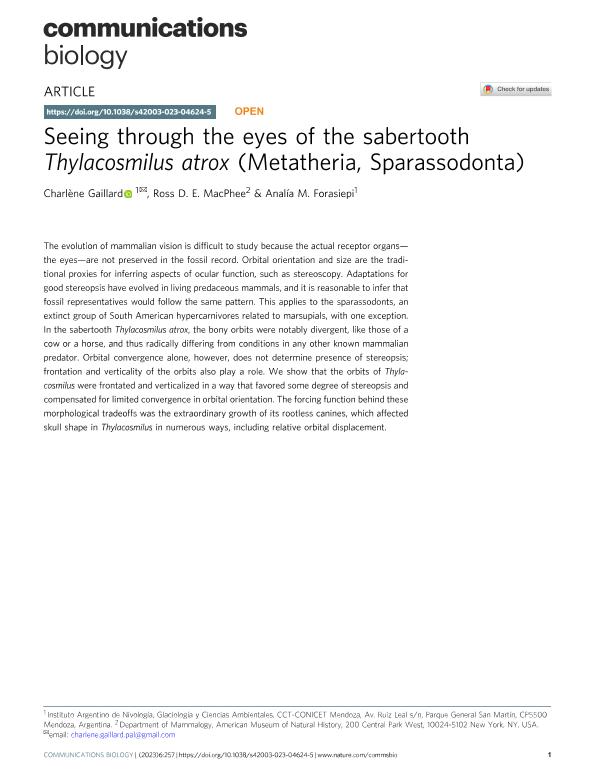Mostrar el registro sencillo del ítem
dc.contributor.author
Gaillard, Charlene

dc.contributor.author
MacPhee, Ross D. E.
dc.contributor.author
Forasiepi, Analia Marta

dc.date.available
2024-03-20T13:17:16Z
dc.date.issued
2023-03
dc.identifier.citation
Gaillard, Charlene; MacPhee, Ross D. E.; Forasiepi, Analia Marta; Seeing through the eyes of the sabertooth Thylacosmilus atrox (Metatheria, Sparassodonta); Nature; Communications Biology; 6; 1; 3-2023; 1-7
dc.identifier.issn
2399-3642
dc.identifier.uri
http://hdl.handle.net/11336/231025
dc.description.abstract
The evolution of mammalian vision is difficult to study because the actual receptor organs—the eyes—are not preserved in the fossil record. Orbital orientation and size are the traditional proxies for inferring aspects of ocular function, such as stereoscopy. Adaptations for good stereopsis have evolved in living predaceous mammals, and it is reasonable to infer that fossil representatives would follow the same pattern. This applies to the sparassodonts, an extinct group of South American hypercarnivores related to marsupials, with one exception. In the sabertooth Thylacosmilus atrox, the bony orbits were notably divergent, like those of a cow or a horse, and thus radically differing from conditions in any other known mammalian predator. Orbital convergence alone, however, does not determine presence of stereopsis; frontation and verticality of the orbits also play a role. We show that the orbits of Thylacosmilus were frontated and verticalized in a way that favored some degree of stereopsis and compensated for limited convergence in orbital orientation. The forcing function behind these morphological tradeoffs was the extraordinary growth of its rootless canines, which affected skull shape in Thylacosmilus in numerous ways, including relative orbital displacement.
dc.format
application/pdf
dc.language.iso
eng
dc.publisher
Nature

dc.rights
info:eu-repo/semantics/openAccess
dc.rights.uri
https://creativecommons.org/licenses/by/2.5/ar/
dc.subject
Stereoscopy
dc.subject
Sparassodonta
dc.subject
Vision
dc.subject
Predation
dc.subject.classification
Paleontología

dc.subject.classification
Ciencias de la Tierra y relacionadas con el Medio Ambiente

dc.subject.classification
CIENCIAS NATURALES Y EXACTAS

dc.title
Seeing through the eyes of the sabertooth Thylacosmilus atrox (Metatheria, Sparassodonta)
dc.type
info:eu-repo/semantics/article
dc.type
info:ar-repo/semantics/artículo
dc.type
info:eu-repo/semantics/publishedVersion
dc.date.updated
2024-03-13T15:17:29Z
dc.journal.volume
6
dc.journal.number
1
dc.journal.pagination
1-7
dc.journal.pais
Estados Unidos

dc.description.fil
Fil: Gaillard, Charlene. Consejo Nacional de Investigaciones Científicas y Técnicas. Centro Científico Tecnológico Conicet - Mendoza. Instituto Argentino de Nivología, Glaciología y Ciencias Ambientales. Provincia de Mendoza. Instituto Argentino de Nivología, Glaciología y Ciencias Ambientales. Universidad Nacional de Cuyo. Instituto Argentino de Nivología, Glaciología y Ciencias Ambientales; Argentina
dc.description.fil
Fil: MacPhee, Ross D. E.. American Museum of Natural History; Estados Unidos
dc.description.fil
Fil: Forasiepi, Analia Marta. Consejo Nacional de Investigaciones Científicas y Técnicas. Centro Científico Tecnológico Conicet - Mendoza. Instituto Argentino de Nivología, Glaciología y Ciencias Ambientales. Provincia de Mendoza. Instituto Argentino de Nivología, Glaciología y Ciencias Ambientales. Universidad Nacional de Cuyo. Instituto Argentino de Nivología, Glaciología y Ciencias Ambientales; Argentina
dc.journal.title
Communications Biology
dc.relation.alternativeid
info:eu-repo/semantics/altIdentifier/url/https://www.nature.com/articles/s42003-023-04624-5
dc.relation.alternativeid
info:eu-repo/semantics/altIdentifier/doi/http://dx.doi.org/10.1038/s42003-023-04624-5
Archivos asociados
